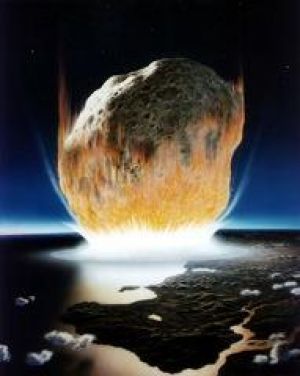Deep impact unlikely
October 12, 2008
People seem to take perverse pleasure in imagining how the world might end, and one wildly popular end-game theory is that a giant asteroid will smash into the Earth, exterminating all life.
But what are the chances that a significantly large object will crash into Earth within the next few generations, wiping out all living species?
“An impact that large is very unlikely,” said Brian Thomas, assistant professor of physics and astronomy at Washburn. “We know of at least five major mass extinctions on Earth, with the last one occurring about 100 million years ago. But it didn’t wipe out all life. It only wiped out about half of the species.”
Humans will likely take cold comfort knowing that when the next huge asteroid strikes, it will merely trigger a mass extinction instead of total annihilation of life. But Thomas said mankind has nothing to worry about because of the eons of time that mark the periods between each cataclysmic meteor.
“We probably have a major meteor impact every 100 million years or so,” said Thomas. “To put this to scale, the dinosaurs died out 65 million years ago [when a meteor struck the Gulf of Mexico].”
In all probability, this means Earth has an infinitesimally long time to wait before its next encounter with a giant meteor – at least 35 million years. And although large asteroids do sometimes pass near Earth, using the word “near” is a relative term in the vast openness of space, where Earth’s nearest neighbor, the moon, is approximately 238,855 miles away.
“Occasionally, you’ll see something in the news about a close pass,” said Thomas, “but a close pass is considered to range anywhere from hundreds of thousands of kilometers, up to 100 million kilometers away.”
On Wednesday night, astronomers in Africa witnessed a large meteor burn up in the atmosphere, according to a news report from MSNBC. Although most asteroids are the size of a grain of sand, this one was the size of a car. Still, scientists said it wasn’t large enough to pose a threat to people on the ground. To cause any significant threats to life on earth, scientists say a meteor must be at least one kilometer (approximately 3,280 ft.) in length.
The Web site for “Science Daily” says that the next time a killer asteroid comes anywhere near the earth will be in 2029, when a 400-meter (approximately 1,312 ft.) asteroid known as “Apophis” will pass between the earth and the moon. The asteroid will come so close to earth that it will be visible to the naked eye, although it will not threaten mankind with extinction. That honor will likely go to some as-yet-unknown, unnamed asteroid in the very distant future.



